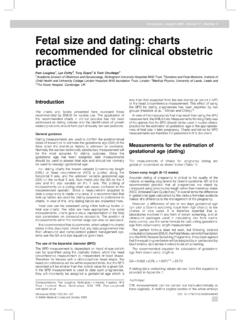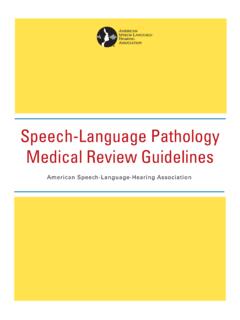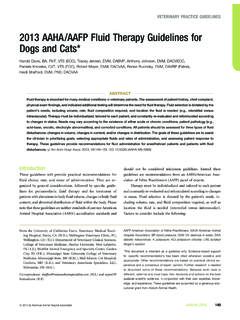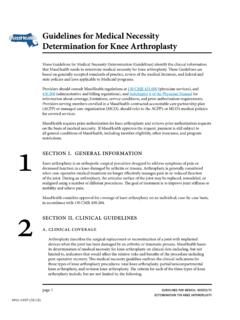Transcription of Guidelines for Professional Ultrasound Practice - BMUS
1 Guidelines forProfessional Ultrasound Practice Society and College of Radiographers and British Medical Ultrasound Society Revision 5. December 2020 SCoR/BMUS Guidelines for Professional Ultrasound Practice . Revision 5, December 2020 1 SOCIETY AND COLLEGE OF RADIOGRAPHERS AND BRITISH MEDICAL Ultrasound SOCIETY Guidelines for Professional Ultrasound Practice DECEMBER 2015 Revision 5, December 2020. Contents Foreword to the December 2015 edition .. 4 Rationale and Terminology used within the 4 Publication History Summary .. 7 SECTION 1: Introduction .. 8 Explanation of the Professional Title Sonographer .. 8 Registration for Sonographers .. 9 Professional standards Authority report on sonographer regulation [2019] .. 10 Profession vs Tool .. 11 Screening examinations using Ultrasound .. 11 SECTION 2: Governance and Safety .. 14 Code of Practice for Sonographers.
2 14 Professional Indemnity .. 15 Safety of Medical Ultrasound .. 16 Medico-legal Issues .. 18 Transducer and Equipment Cleaning and Disinfection [updated 2020] .. 19 Ergonomic Practice including managing the high BMI patient .. 20 Intimate examinations and chaperones .. 23 Examination times .. 24 The 6 C s, patient identification, communication and consent .. 25 Clinical Governance .. 27 Ultrasound equipment and quality assurance testing .. 29 Professional responsibilities and safeguarding .. 30 Raising concerns .. 30 Safeguarding .. 30 Female Genital Mutilation (FGM) - statutory requirements of practitioners .. 31 Duty of Candour .. 31 Conscientious objection .. 31 SCoR/BMUS Guidelines for Professional Ultrasound Practice . Revision 5, December 2020 2 Acquisition, archiving and use of Ultrasound 32 Recording of images by patients during examinations [2019] .. 34 Have you paused and checked posters and prompt cards.
3 34 Independent Practice .. 34 SECTION 3: Education and Accreditation .. 38 E-learning for Healthcare .. 38 Quality Standard for Imaging (QSI) [updated 2019, previously ISAS standard] .. 39 Continuing Professional Development .. 39 Audit and learning from discrepancy .. 41 SECTION 4: The Ultrasound Examination .. 47 Overview of Ultrasound examination procedures .. 47 Obstetric, Vascular, Echocardiography and Breast examinations .. 47 NICE and other Guidelines .. 48 Vetting of Ultrasound requests .. 49 Justification of Ultrasound 49 Recommendations for the production of an Ultrasound 51 Gynaecological Ultrasound examinations .. 58 General scanning principles .. 58 Structures to examine and evaluate .. 59 Common Pathologies .. 60 Extending the examination .. 66 Pelvic Ultrasound reporting .. 66 Abdominal Ultrasound examinations .. 69 General principles .. 69 Ultrasound examination of the liver .. 73 Ultrasound examination of the gallbladder and biliary tree.
4 74 Transabdominal Ultrasound examination of the pancreas .. 77 Ultrasound examination of the spleen .. 78 Ultrasound examination of the abdominal aorta [2018] .. 81 Ultrasound examination of the bowel .. 82 Uro-genital system including testes and scrotum .. 88 Ultrasound examination of the kidneys [2018] .. 88 Ultrasound examination of the testes and scrotum [2018] .. 92 Ultrasound examination of the adult head and neck .. 95 Paediatric Ultrasound examinations .. 100 Paediatric liver and biliary system .. 100 Paediatric urinary 105 Paediatric gastro-intestinal tract .. 107 SCoR/BMUS Guidelines for Professional Ultrasound Practice . Revision 5, December 2020 3 Neonatal hip .. 108 Neonatal intracranial Ultrasound .. 109 Musculoskeletal Ultrasound examinations .. 110 Shoulder .. 112 Elbow .. 117 Wrist and hand .. 120 Hip .. 123 Knee .. 125 Foot and Ankle .. 127 Rheumatology Ultrasound examinations .. 130 Elastography.
5 142 Contrast enhanced Ultrasound (CEUS).. 144 Interventional and extended scope examinations for sonographers [2018] .. 147 Patient group directions .. 147 151 SCoR/BMUS Guidelines for Professional Ultrasound Practice . Revision 5, December 2020 4 Foreword to the December 2015 edition It is my pleasure to introduce the updated Guidelines for Professional Ultrasound Practice , in the past affectionately known to sonographers as the UKAS Guidelines . The United Kingdom Association of Sonographers (UKAS) was set up to support sonographers, provide advice and Practice guidance and ultimately get sonography recognised as a profession in its own right. To this day the latter still remains a challenge! However, since the last edition of the Guidelines was produced in 2008, UKAS has merged with SCOR, so, while UKAS no longer exists, its legacy lives on in this revised document. It is a testament to the quality of the original Guidelines that some sections are relatively unchanged.
6 The advice is as equally sound and relevant today as it was then. Guidelines , however, need to keep in step with evolving technology, changes in Practice and Professional progression. For this reason, it was decided to produce the revised version as a web-based document that can be regularly updated, amended and expanded as and when required. As with all previous editions, these Guidelines are not designed to be prescriptive but to inform good Practice . May they continue to be used in departments across the United Kingdom for years to come. Wendy Williams Member, Ultrasound Advisory Group, Society and College of Radiographers. Former UKAS committee member December 2015 Rationale and Terminology used within the document These current Guidelines are a collaboration between the Society and College of Radiographers (SCoR) and the British Medical Ultrasound Society (BMUS). The format of a web-based document provides easier access to relevant sections and hyperlinks, whilst allowing for annual updates.
7 Some links within the Guidelines are to members only SCoR or BMUS content and may require additional log-on. The document has been written to complement the 2014 joint document by the Royal College of Radiologists (RCR) and the Society and College of Radiographers entitled standards for the Provision of an Ultrasound Service 1. It provides guidance on topics that were not included in the joint RCR/SCoR standards document and provides further detailed advice on some areas of Practice that were. There can be overlap between the terms standards , Guidelines and Protocols and this can cause confusion. For the purposes of this document, the definitions used are the same as those in the 2014 Royal College of Radiologists (RCR) and Society and College of Radiographers (SCoR) document1. Standard: A required or agreed level of quality or attainment. A standard is a way of ensuring optimum levels of care or service delivery. standards promote the likelihood of an Ultrasound examination being delivered safely and effectively, are clear about what needs to be done to comply, are informed by an evidence base and are effectively measurable 1.
8 Guideline: A general rule, principle or piece of advice. Guidelines provide recommendations on how Ultrasound examinations should be performed and are based on best available evidence. SCoR/BMUS Guidelines for Professional Ultrasound Practice . Revision 5, December 2020 5 They help Ultrasound practitioners in their work but they do not replace their knowledge and skills 1. Protocol: An agreement, preferably based on research, between practitioners to ensure the delivery of high quality standardised Ultrasound examinations. These Guidelines , which are not prescriptive, are made available to be used as recommendations for good Practice . Since the first publication of the UKAS Guidelines for Professional Working Practice ' in 1993, service provision, technology and patient expectations in medical Ultrasound have been transformed. The examination-specific section, including Guidelines and common clinical scenarios (ref: section 4) has been compiled by the British Medical Ultrasound Society Professional standards team and is presented as examples of best Practice .
9 They have been included so that departments can use them as a basis to generate their own departmental examination protocols when there are no nationally agreed ones available. There are also sections giving general guidance and advice, including reporting and audit. Hyperlinks have been extensively used within the text to give access to the many relevant documents already published on a wide range of topics by organisations other than the SCoR and BMUS. There are no Guidelines included for obstetric Ultrasound within these Guidelines . Practitioners are referred to publications from other sources such as the national fetal anomaly screening programmes, the Royal College of Obstetricians and Gynaecologists (RCOG) (especially their Greentop Guidelines ), National Institute for Health and Care Excellence (NICE), the Fetal Medicine Foundation (FMF), Association of Early Pregnancy Units (AEPU), British Society of Gynaecological Imaging (BSGI), and the International Society of Ultrasound in Obstetrics and Gynaecology (ISUOG).
10 The term patient has been used throughout the document in preference to other terms such as client or service user. Several Professional titles are used by those who Practice Ultrasound and this can lead to considerable confusion. The term Ultrasound practitioner is used throughout this document when appropriate to do so. This is consistent with use of this term within the 2014 RCR/SCoR document standards for the provision of an Ultrasound service 1, which uses the definition: Ultrasound Practitioner: A healthcare Professional who holds recognised qualifications in medical Ultrasound and is able to competently perform Ultrasound examinations falling within their personal scope of Practice . The Professional background of Ultrasound practitioners can be very varied and will include radiologists, radiographers, sonographers, midwives, physiotherapists, obstetricians and clinical scientists 1. A definition of sonographer that is used in connection with the Public Voluntary Register of Sonographers (PVRS) which is administered by the SCoR2 can be found in Section 1.













